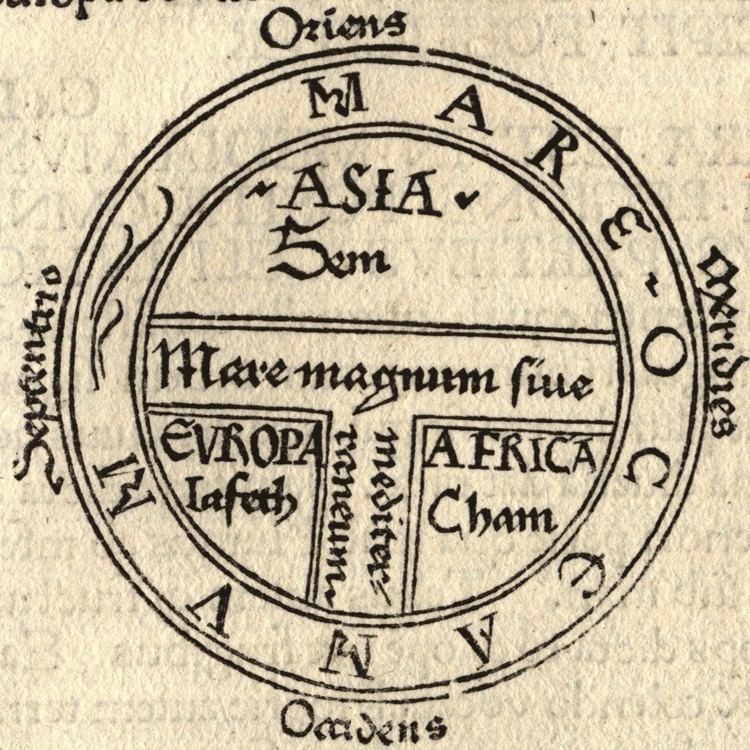 | ||
Japhetite (also Japhethitic, Japhetic) in Abrahamic religions is an historical obsolete term for the peoples supposedly descended from Japheth, one of the three sons of Noah in the Bible. The other two sons of Noah, Shem and Ham, are the eponymous ancestors of the Semites and the Hamites, respectively.
Contents
In medieval ethnography, the world was believed to have been divided into three large-scale racial groupings, corresponding to the three classical continents: the Japhetic peoples of Europe, the Semitic peoples of Asia and the Hamitic peoples of Africa.
The term has been used in modern times as a designation in physical anthropology, ethnography and comparative linguistics. In anthropology, it was used in a racial sense for "white people" (the Caucasian race). In linguistics it was used as a term for the Indo-European languages. These uses are now mostly obsolete. In a linguistic sense, only the Semitic peoples form a well-defined family. The Indo-European group is no longer known as "Japhetite", and the Hamitic group is now recognized as paraphyletic within the Afro-Asiatic family.
Biblical genealogy
It is written in Genesis: "The sons of Japheth: Gomer, and Magog, and Madai, and Javan, and Tubal, and Meshech, and Tiras. and the sons of Gomer: Ashkenaz, and Riphath, and Togarmah. And the sons of Javan: Elishah, and Tarshish, Kittim, and Dodanim. By these were the Isles of the Gentile divided in their lands everyone after his tongue, after their families, in their nations." (Gen 10:2-5)
In the Bible, Japheth is ascribed seven sons and seven named grandsons:
The intended ethnic identity of these 'descendants of Japheth' is not certain; however, over history, they have been identified by Biblical scholars with various historical nations who were deemed to be descendants of Japheth and his sons — a practice dating back at least to the classical encounters of Jew with Hellene, for example in Josephus's Antiquities of the Jews, I.VI.122 (Whiston). Josephus wrote:
Japhet, the son of Noah, had seven sons: they inhabited so, that, beginning at the mountains Taurus and Amanus, they proceeded along Asia, as far as the river Tanais (Don), and along Europe to Cadiz; and settling themselves on the lands which they light upon, which none had inhabited before, they called the nations by their own names.Josephus detailed the nations supposed to have descended from the seven sons of Japheth.
Pseudo-Philo
An ancient, relatively obscure text known as Pseudo-Philo and thought to have been originally written ca. 70 AD, contains an expanded genealogy that is seemingly garbled from that of Genesis, and also different from the much later one found in Jasher:
Later writers
Among the nations that various later writers (including Jerome and Isidore of Seville, as well as other traditional accounts) have attempted to assign to them, are as follows:
Irish and Armeniano-Caucas has many different origins, also Italy was populated by many peoples.
Book of Jasher
The "Book of Jasher", a midrash (elaboration of the biblical text) first printed in 1625, ostensibly based on an earlier edition of 1552, provides some new names for Japheth's grandchildren.
Anthropology
The term Caucasian as a racial label for Europeans derives in part from the assumption that the tribe of Japheth developed its distinctive racial characteristics in the Caucasus area, having migrated there from Mount Ararat before populating Europe. In the same vein, Georgian nationalist histories associated Japheth's sons with certain ancient tribes of the Caucasus area, called Tubals (Tabals, Tibarenoi in Greek) and Meshechs (Meshekhs/Mosokhs, Moschoi in Greek), who they claimed represented ancient pre-Indo-European and non-Semitic, possibly "Proto-Iberian", tribes of Asia Minor of the 3rd-1st millennias BC. This theory influenced the use of the term Japhetic in the linguistic theories of Nikolai Marr (see below).
During the eighteenth and nineteenth centuries, the Biblical statement attributed to Noah that "God shall enlarge Japheth" (Genesis 9:27) was used by some preachers as a justification for the "enlargement" of European territories through imperialism, which they interpreted as part of God's plan for the world. The subjugation of Africans was similarly justified by the curse of Ham.
Linguistics
The term Japhetic was also applied by William Jones, Rasmus Rask and others to what is now known as the Indo-European language group.
The term was used in a different sense by the Soviet linguist Nicholas Marr, in his Japhetic theory, which was intended to demonstrate that the languages of the Caucasus formed part of a once-widespread pre-Indo-European language group.
